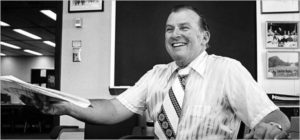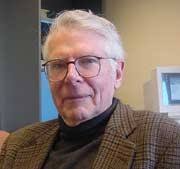“Remembering Joe Kauffman and the Early Days of Peace Corps Training”
Remembering Joe Kauffman
and the Early Days of Peace Corps Training
by Ted Vestal (Staff: PC/Washington & Ethiopia APCD 1963–66)
JOSEPH KAUFFMAN, ONE OF THE founding hands of the Peace Corps died September 29, 2006 in Madison, Wisconsin. From 1961–1963, Joe was the first Director of Training at a time when no one knew what a Peace Corps was supposed to be — much less how to train Volunteers. In the old Peace Corps Headquarters at 806 Connecticut Avenue, he ran a respected Division staffed by some well-degreed, experienced former university professors and administrators. They worked on a crash basis primarily with colleges and universities which at the time had not had much experience in training Americans to work overseas. The Training Division’s activities were informed by a series of conferences the Peace Corps had held in 1961 on how to train Volunteers for service in particular nations of Asia, the Far East, Africa and Latin America and on subjects deemed essential to prepare PCVs for overseas service.
Like many of the Peace Corps/Washington staff, Joe was an ambitious, energetic veteran of World War II, having seen combat as an infantry sergeant in North Africa and Italy. He earned a doctorate at Boston University and worked as Regional Director of the Anti-Defamation League in Omaha and Denver before becoming Assistant to the President and Dean of Students at Brandeis University. At the time Sargent Shriver asked him to join the fledgling Peace Corps, Joe was Executive Vice President of the Jewish Theological Seminary of America. Joe was the type of academician that Sarge liked: a take-charge, get it done kind of guy who worked directly with students. Kauffman was respected for his intellect and well-liked for his personal dealings with colleagues.
Shriver and his cohorts rigorously debated the training of PCVs during the early 1961 planning seminars at the Mayflower Hotel. First, they were concerned with how to prepare what President Kennedy had described as “all those with the desire and capability to help foreign lands meet their urgent needs for trained personnel.” Secondly, the planners had to demonstrate that training of PCVs could counter critics of the Peace Corps who envisioned ill-informed kids running off to foreign countries, disrupting U.S. foreign aid policies.
The Mayflower Hotel discussions and heated arguments produced several dominant ideas that became the basis for Kauffman’s early training contracts. Chief among these were the models of 1) the Experiment in International Living, 2) Outward Bound programs, 3) the use of psychiatrists in training, and 4) knowledge of American government and institutions sufficient to be able to defend them in debate with would-be detractors.
Shriver’s participation in the Experiment in International Living in Germany and France in the 1930s doubtlessly was a strong force in shaping his picture in the head of what PCVs might encounter overseas and what type of training should prepare them for it. The Experiment programs featured home-stays and the development of some empathy with overseas hosts, knowledge of the culture and society of the countries being visited, and some facility with foreign languages. Obviously one had to be in good physical condition to take part in bicycle-camping tours that were integral to the Experiment.
Outward Bound training had been developed in Britain in World War II to give young seamen the ability to survive harsh conditions at sea by teaching confidence and tenacity. Joshua Miner of Phillips Academy had brought the innovative program to the United States in the 1950s, and Shriver contacted him about adventure based, experiential learning. The entire Outward Bound philosophy of impelling participants to achieve more than they ever thought possible through exacting physical challenges and of team-building and development of compassion for others through bold undertakings fit the adventurous image Shriver wanted the Peace Corps to have.
The use of psychiatrists as an integral part of the Peace Corps operation probably stemmed in part from Sarge and Eunice Shriver’s experience with the Kennedy Foundation and its emphasis on mental retardation. In a staff meeting in June 1962, Shriver discussed with his medical staff how psychiatrists could be used in training. They concluded that psychiatrists could assist the Medical Division in selecting out the medically unfit Volunteers and selecting in the psychologically sound ones judged capable of coping with adventurous hardship in the field: a process of “strengthening the healthy” for their service abroad.
From the beginning, the Peace Corps was the target of Communist propagandists. The Soviet Union, PRC, Castro’s Cuba, and other leftist governments denounced the organization as a tool of capitalist imperialism. President Kennedy contended, however that “our young men and women, dedicated to freedom, are fully capable of overcoming the efforts of Mr. Khrushchev’s missionaries who are dedicated to undermining that freedom.” How to prepare PCVs to be well-versed in understanding U.S. government, society, and culture in order to stand up to false allegations that Marxists/Leninists were likely to bring up where ever the Peace Corps went became a challenge to Kauffman and the Training staff.
Under pressure and short deadlines to get training started and PCVs into the field, Shriver had Albert Sims, head of the Institute of International Education, solicit universities and colleges for domestic training. Kauffman and associates then worked with university representatives to create training curricula. Sometimes the demands of the Peace Corps were difficult for the academy to meet. The most useful foreign language instruction for PCVs would emphasize the spoken word and conversational ability. Yet this was to be done by foreign language departments that had been churning out majors in European languages with the hope that the graduates would be specialists in the literature being studied. In the early 1960s much language instruction still was rote memorization of the “amo, amas, amat” variety of Latin learning. By holding the professors’ feet to the fire to produce practical results in preparing PCVs to communicate in their host countries, the Peace Corps helped modernize the curricula of foreign language instruction throughout the country. Likewise, the academy did not have much experience in cross-cultural training, so improvisation was rampant. Universities were more successful in teaching civics and history, preparing Volunteers “to discuss adequately and intelligently the United States when questioned.”
The first training programs were held at the University of California, Berkeley, for Volunteers going to Ghana, and at Texas Western College for those assigned to Tanganika. These were the trailblazers for a legion of subsequent training programs throughout the nation that prepared PCVs for service in countries that many people had not been aware of only a few years before. Somehow Kauffman and his team came up with a mixture of idealism, naiveté, and brilliance that infused the training programs with a spirit and content that gave the PCVs a quick inoculation against ignorance about their assigned countries.
One of the most publicized training sites was the Puerto Rican Field Training Center, located in the mountains south of Arecibo. There PCVs received Outward Bound Training designed to generate self-confidence and erase unreasonable fears of the unknown. Many trainees were not sure about the connection of the training to their teaching or community development assignments, but the media reveled in reporting the strenuous physical training, the repelling down dams, rock climbing, drown-proofing, swimming several lengths of a pool underwater, and four-day survival treks. The Outward Bound experience actually came to play a less significant role in training after the first two years of high profile exposure in Puerto Rico.
The Training Division under Kauffman learned as it went along and brought pressure to bear on universities to reform and improve as they negotiated contracts for new training programs. The entire training operation in a hitherto untracked area was a culturally awakening experience for some Ivory Tower academics. The procedures and experience gained by working with the Training Division in the early days of the Peace Corps yielded rich dividends to higher education in general and to other Government agencies as well.
In 1962, Kauffman figured in an iconic Peace Corps tale. On a visit to Ethiopia, Shriver asked Emperor Haile Selassie if he could pet the Emperor’s pet lion Tojo. Joe Coleman, Director of Peace Corps Research at the time, purportedly turned to Kauffman and asked, “What is the line of succession at the Peace Corps, anyway?” Joe’s reply was not recorded.
After he left the Peace Corps, Kauffman joined the University of Wisconsin-Madison in 1965 as Dean of Student Affairs. In July 1968 he returned to his home state to become president of Rhode Island College where he served until January 1973. He then returned to Madison, where he was a professor in the University’s Department of Educational Administration and continued his lifelong commitment to public service via a variety of positions well after his retirement in 1987.
•
Ted Vestal, Professor Emeritus of Political Science at Oklahoma State University, went to Ethiopia as an APCD in 1964. Since then, Dr. Vestal has maintained an interest in Ethiopia and the Peace Corps. He is the author of The Lion of Judah in the New World: Emperor Haile Selassie of Ethiopia and the Shaping of Americans’ Attitudes toward Africa. 



No comments yet.
Add your comment